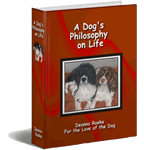|
Let's
Talk Dog Food - 'Dog Food 101'
Part 3
In Part 2 of my 'Dog Food 101,' I discussed some
meat/protein sources, now I'd like to go over some information on carbohydrates.
The first thing I would like to say is that dogs, being carnivores, do not require grains and cereals in their
diets. Secondly, they are not well processed by their bodies which means nutritionally, they are of little value.
If you recall, in Part 1, I said that dogs "have short digestive tracts and their bodies lack certain enzymes which
make it difficult, if not impossible for their bodies to process grains and vegetables unless they are
‘predigested’ by processing; cooking, mincing, grinding, breakdown by enzymes, or fermentation through
bacteria."
Keeping this in mind, let's take a look at some of the carbs; cereals and grains, that are in our pet's food.
One of the most prevalent is corn in a variety of forms. Most are 'by-products' left over after processing what can
be used for human consumption and are usually to add bulk or fiber and are seldom of much if any nutritional value.
They are basically just cheap fillers. Another thing to keep in mind is that corn is one of the highest reported
food allergens in dogs.
Corn/Ground Corn - AAFCO -- Ground Corn is the entire corn kernel, ground or chopped.
Corn Bran - AAFCO - The outer coating of the corn kernel, with little or none of the starchy part
of the germ.
Corn Cellulose - AAFCO -- A product obtained from the cell walls of corn.
Corn Germ Meal - AAFCO -- Ground corn germ which consists of corn germ with other parts of the
corn kernel from which part of the oil has been removed and is obtained from either a wet or dry milling
manufacturing process of corn meal, corn grits, hominy feed, or other corn products.
Corn Gluten/Meal - AAFCO -- The dried residue from corn after the removal of the larger part of
the starch and germ, and the separation of the bran by the process employed in the wet milling manufacture of corn
starch or syrup, or by enzymatic treatment of the endosperm.
The corn germ meal and corn gluten meal both do actually contain protein but are mainly used as binders and cheap
protein boosters in low quality food.
Next, you see a lot of 'rice' products in ingredients lists. Until I did some research I thought this was 'good
stuff,' just like the manufacturers want you to think.
Brewers Rice - AAFCO -- The dried extracted residue of rice resulting from the manufacture of wort
(liquid portion of malted grain) or beer and may contain pulverized dried spent hops in an amount not to exceed 3
percent. The small milled fragments of rice kernels that have been separated from the larger kernels of milled
rice.
This is just another left over. It's the bits and pieces that are left over after whole grain and brown rice is
processed for human consumption and actually is nutritionally depleted.
Rice Hulls - AAFCO - The outer covering of rice.
Another by-product used as a cheap fiber and filler.
Rice Flour - AAFCO -- Rice Flour consists principally of the soft, finely ground and bolted meal
obtained from milling rice (containing essentially the starch and gluten of the endosperm) together with fine
particles of rice bran and the offal from the 'tail of the mill.'
A highly pre-processed rice product that through processing has most if not all nutritional properties leeched from
it.
Are you getting the idea? Left-overs, by-products, cheap fibers, fillers and protein boosters, of little to no
nutritional value.
When you look at the above, would you expect anything of higher quality in the wheat, oat, soy and other
miscellaneous cereals and grains? You can also be sure that even when you find 'whole' products listed such as
brown rice, whole grain rice or potato, they are what is leftover after the products are processed and what can be
used for human consumption is removed.
And here's a side note on soy products, soybeans have been reported to be the number one food allergen for dogs.
Soy is virtually unusable by an animal's body because they lack the essential amino acid to digest soy products.
Soy has also been linked to bloat and gas in many dogs.
So there's a bit on the carbs; cereals and grains, that manufacturers put in your pet's food. Not only does your
dog not really need them, most are highly indigestible and of such poor quality that there is little, if any
nutritional value to even be derived from them. They can mostly be classified as cheap fibers, fillers and protein
boosters.
Next time we'll go into some of the chemicals that dog food is just chock full of. It will be yet another
eye-opening exposure to the world of 'commercial' dog food.
by Deanna Raeke
Back to
Top
###
| 





